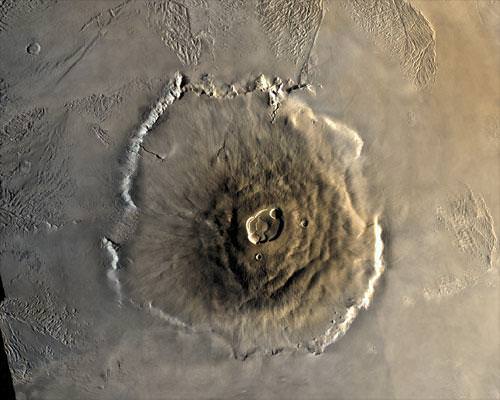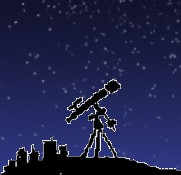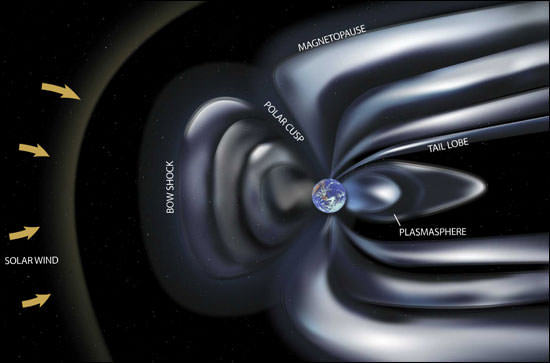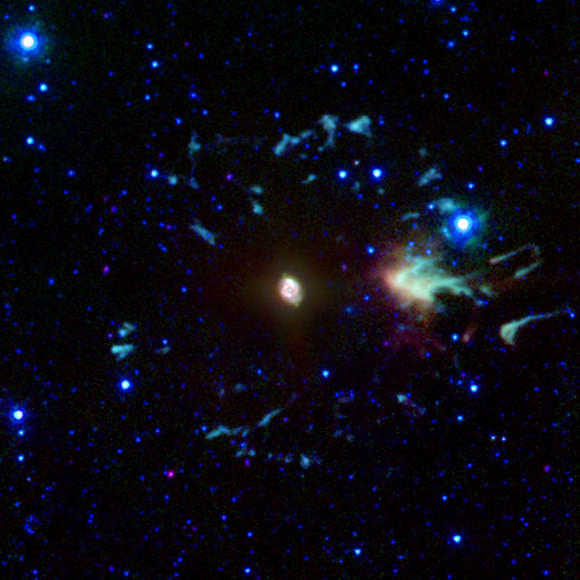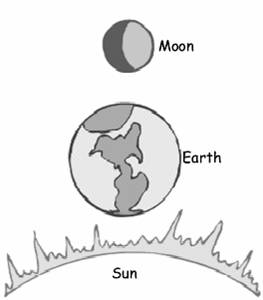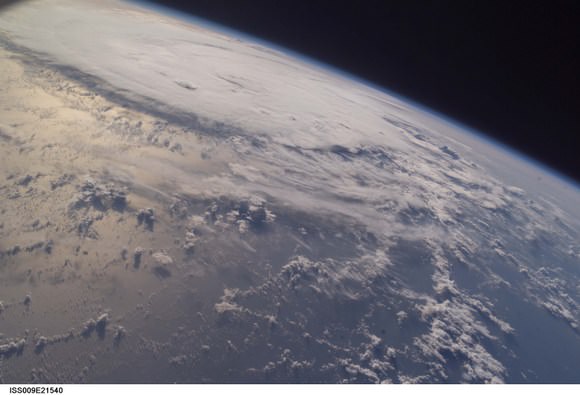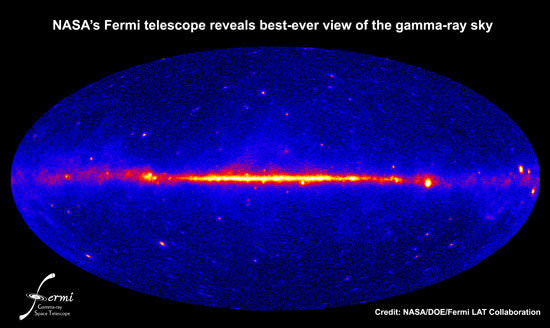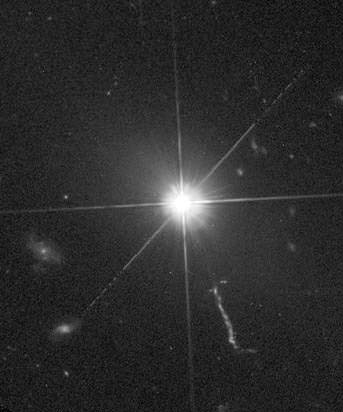Greetings, fellow SkyWatchers! With the Moon gone from the early evening skies, it’s time for a little sky dancing this weekend. Are you ready for a little old stepping out and a little new? Then waltz this way as we check out some very new star clusters and interesting asterisms! Grab your binoculars and telescopes and I’ll meet you in the back yard….
 Friday, March 13, 2009 – Today note the 1886 birth of Albert William Stevens, a daring balloonist who took the Explorer II to an altitude of 72,395 feet. He took the first photo showing Earth’s curvature and the first solar eclipse photo of the Moon’s shadow on Earth. Also, salute the 1855 birth on this date of Percival Lowell, who predicted the existence of Pluto (but Clyde Tombaugh was the one who actually discovered it, on Lowell’s 75th birthday!). Sir Percival was a determined soul who spent his life trying to find proof of life on Mars. He founded Lowell Observatory in 1894, where he studied Mars intensively, drawing the Red Planet covered with canals and oases. As Lowell once said: ‘‘Imagination is as vital to any advance in science as learning and precision are essential for starting points.’’
Friday, March 13, 2009 – Today note the 1886 birth of Albert William Stevens, a daring balloonist who took the Explorer II to an altitude of 72,395 feet. He took the first photo showing Earth’s curvature and the first solar eclipse photo of the Moon’s shadow on Earth. Also, salute the 1855 birth on this date of Percival Lowell, who predicted the existence of Pluto (but Clyde Tombaugh was the one who actually discovered it, on Lowell’s 75th birthday!). Sir Percival was a determined soul who spent his life trying to find proof of life on Mars. He founded Lowell Observatory in 1894, where he studied Mars intensively, drawing the Red Planet covered with canals and oases. As Lowell once said: ‘‘Imagination is as vital to any advance in science as learning and precision are essential for starting points.’’
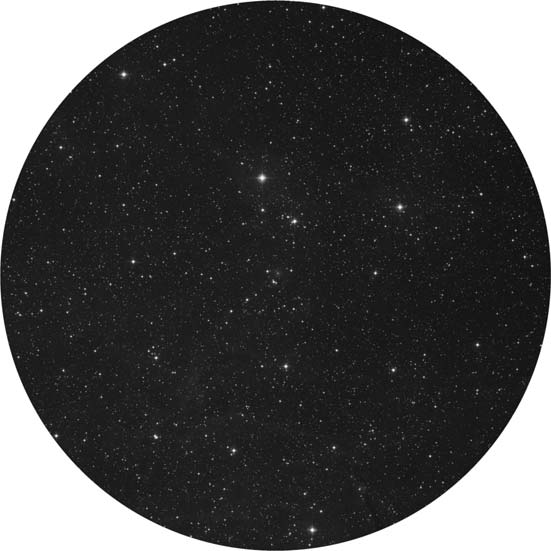
Tonight we’ll look at a bright collection of stars located less than a handspan west of Procyon. Its name is Collinder 106 (RA 06 37 19 Dec -05 57 55). At a combined magnitude of 4.5, this expansive open cluster can be spotted as a hazy patch with the unaided eye and comes to full resolution with binoculars. It contains only around 14 members, but this widely scattered galactic collection has helped scientists determine size scales and dispersion among groups of its type. Viewed telescopically at low power, the observer will find it rich in background stars and a true delight in a low power, wide field eyepiece. If you’d like a challenge, hop a half degree to the northeast to spot Collinder 111 (RA 06 38 42 Dec -06 54 00). While visually only about one-tenth the apparent size of its larger southwestern neighbor, spare little Collinder 111 also belongs to the same class of open clusters. Who knows what may lurk around these understudied clusters?
Saturday, March 14, 2009 – Before dawn, look for the close appearance of Spica and the Moon to celebrate today’s famous astro births, starting with astronaut Frank Borman (b. 1928), a crew member of Apollo 8, the first manned flight around the Moon. Next, astronaut Eugene Cernan (b. 1934), who floated in space for more than 2 hours during the Gemini 9 mission and piloted Apollo 10. How about Giovanni Schiaparelli (1835), the Italian astronomer who described Mars’s ‘‘canali’’ and named its ‘‘seas’’ and ‘‘continents.’’ Schiaparelli’s comet studies demonstrated that meteoroid swarms existed in the path of cometary orbits, and thus predicted annual meteor showers. He was first to suggest that Mercury and Venus rotate and discovered the asteroid Hesperia. Still not enough? Then wish a happy birthday to Albert Einstein (b.1879), the German–American physicist considered the most brilliant intellect in human history!
 For a moment let’s reflect on Einstein’s Cross, proof of his genius. We can’t observe this Pegasus-based gravitational lens right now, but we can try to understand Einstein’s theory of gravity as an effect of the curvature in space–time. For example, if you draw a line around the center of a ball, the line would be straight, eventually coming back to its point of origin. We don’t see the point until we reach it, but we know it’s there. Einstein knew this dimension existed and predicted any object with mass will bend space and time around it, just like our line around the ball. He predicted light would also follow a curved path around an object… such as a distant quasar located behind a closer galaxy!
For a moment let’s reflect on Einstein’s Cross, proof of his genius. We can’t observe this Pegasus-based gravitational lens right now, but we can try to understand Einstein’s theory of gravity as an effect of the curvature in space–time. For example, if you draw a line around the center of a ball, the line would be straight, eventually coming back to its point of origin. We don’t see the point until we reach it, but we know it’s there. Einstein knew this dimension existed and predicted any object with mass will bend space and time around it, just like our line around the ball. He predicted light would also follow a curved path around an object… such as a distant quasar located behind a closer galaxy!
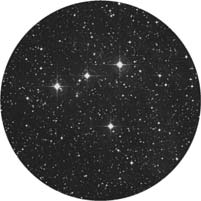 Tonight’s object is a ‘‘cross’’ astersim of stars. Begin at Procyon and shift about 10 degrees southwest (or 2 degrees south of 18 Monocerotis) to locate this pretty grouping of stars. Yes it’s true. It’s just an unknown, undocumented, and unnamed asterism, but how fitting to honor all these famous astro figures and a brilliant man who once said: ‘‘The fairest thing in life we can experience is the mysterious. It… stands at the cradle of true art and true science.’’
Tonight’s object is a ‘‘cross’’ astersim of stars. Begin at Procyon and shift about 10 degrees southwest (or 2 degrees south of 18 Monocerotis) to locate this pretty grouping of stars. Yes it’s true. It’s just an unknown, undocumented, and unnamed asterism, but how fitting to honor all these famous astro figures and a brilliant man who once said: ‘‘The fairest thing in life we can experience is the mysterious. It… stands at the cradle of true art and true science.’’
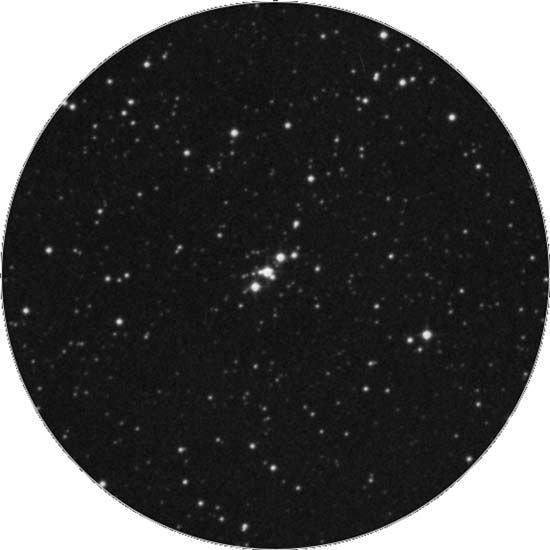
Now let’s go for a a challenging study. Larger telescopes should look for diminutive Bochum 2 less than half a degree northeast of ‘‘Einstein’s Asterism’’ (RA 06 48 50 Dec 00 22 35). At low power, it’s just a tight configuration of stars, but test the limit your telescope and increase magnification. This young open cluster has been studied for internal kinematics, spectroscopic binaries, and its motion in the galaxy, but its most interesting feature is a trapezium system at its heart. After a 4-year study, two of the members were documented as close binary stars with highly eccentric orbits, and one of the members is leaving as a runaway!
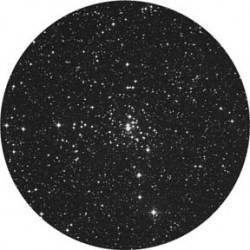 For smaller optics, continue another half degree east for NGC 2301 (RA 06 51 48 Dec -00 28 00). Even telescopes as small as Lacaille’s can see this bright, 2,500 light-year-distant open cluster. Studied for its variable stars, NGC 2301 is also on many binocular deep-sky observing lists!
For smaller optics, continue another half degree east for NGC 2301 (RA 06 51 48 Dec -00 28 00). Even telescopes as small as Lacaille’s can see this bright, 2,500 light-year-distant open cluster. Studied for its variable stars, NGC 2301 is also on many binocular deep-sky observing lists!
Sunday, March 15, 2009 – Today marks the 1713 birth of Abbe Nicolas Louis de Lacaille, the French astronomer who named 15 of the 88 constellations. Using only a half-inch refractor, Lacaille made 26 new discoveries and charted 9,776 stars, creating the first southern star catalog. Sharing the date is William Rutter Dawes (b. 1799). ‘‘Eagle-eyed’’ Dawes made exhaustive measurements of binary stars, discovered Saturn’s inner Crepe Ring, and accurately mapped Mars. Dawes also devised the elegantly simple formula (Dawe’s Limit) of dividing the number 11 by the aperture in centimeters to give the arcseconds of resolution required to split a binary star.
Thankfully, somebody was watching the sky at 5:30 p.m. on this date in 1806, because the observed fall of a pristine 6-kilogram chondrite meteor made an indisputable case that chondrites carried carbon-based organic chemicals. Perhaps it was from one of the Corona Australid meteors whose shower peak is tonight after midnight? The fall rate is about 5–7 per hour, and best for our friends in the southern hemisphere!
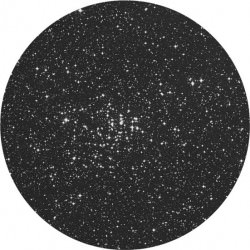 Tonight let’s return to the Einstein’s Asterism and drop 15 degrees due southeast to study open cluster NGC 2360 (RA 07 17 42 Dec -15 38 00). At a distance of 4,600 light-years, magnificent NGC 2360 contains around 40 members, 7 of which are red giants. You have Caroline Herschel to thank for this lovely cluster… and her birthday is tomorrow!
Tonight let’s return to the Einstein’s Asterism and drop 15 degrees due southeast to study open cluster NGC 2360 (RA 07 17 42 Dec -15 38 00). At a distance of 4,600 light-years, magnificent NGC 2360 contains around 40 members, 7 of which are red giants. You have Caroline Herschel to thank for this lovely cluster… and her birthday is tomorrow!
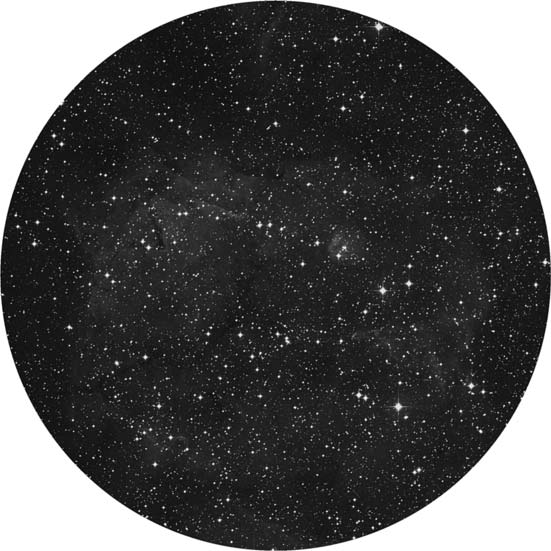
Now, return to our Einstein’s Asterism and head slightly more than half a degree west to study scattered open cluster Dolidze 25 (RA 06 45 06 Dec -00 18 00). This low power, telescopic only, galactic cluster is a worthy study for those who seek the unusual. Located at the outer edges of our own galaxy, Dolidze 25 may very well be the product of the merger of the Milky Way and the Canis Major Dwarf galaxy. Extremely rich in oxygen and significantly deficient in metals, this huge starforming region contains young stars, pre-main sequence stars, and Delta Scuti types. With its thin veil of nebula, Do25 should prove to be challenging and quite to your liking! Hop another half degree west, and then slightly south for Dolidze 23 (RA 06 43 12 Dec -00 00 00). This telescope-only cluster reveals around a dozen easily resolvable stars at low power. Dolidze 23’s two brighter members are finderscope visible. Locate the cluster at low power, and place it at the south edge of the field of view. Turn off your drive units and allow the field to cruise by naturally as you observe. This allows Dolidze 25 to drift across your line of sight, a technique that often improves your ability to spot fine detail in fainter objects.
Celestial scenery alert on Tuesday, March 17! A few hours before dawn, the Moon and mighty Antares will be nearly touching, separated by only a fraction (0.2) of a degree. For some, this could be a wonderful occultation event, so be sure to check maps and resources! Although the occultation path is limited, even more so is the graze path, just a few kilometers wide. For these lucky viewers, brilliant red Antares may flash in and out of view several times as it moves slowly along behind the lunar mountains.
Until next week, dreams really do come true when you keep on reaching for the stars!
This week’s awesome photos are: Sir Percival Lowell (historical image), Collinder 106 (credit – Palomar Observatory, courtesy of Caltech), Einstein’s Cross (credit – HST/NASA), “Einstein’s Asterism’’ (Credit – Palomar Observatory, courtesy of Caltech), Bochum 2, NGC 2301, Dolidize 25 and NGC 2360 (credit – Palomar Observatory, courtesy of Caltech). Thank you so much!

